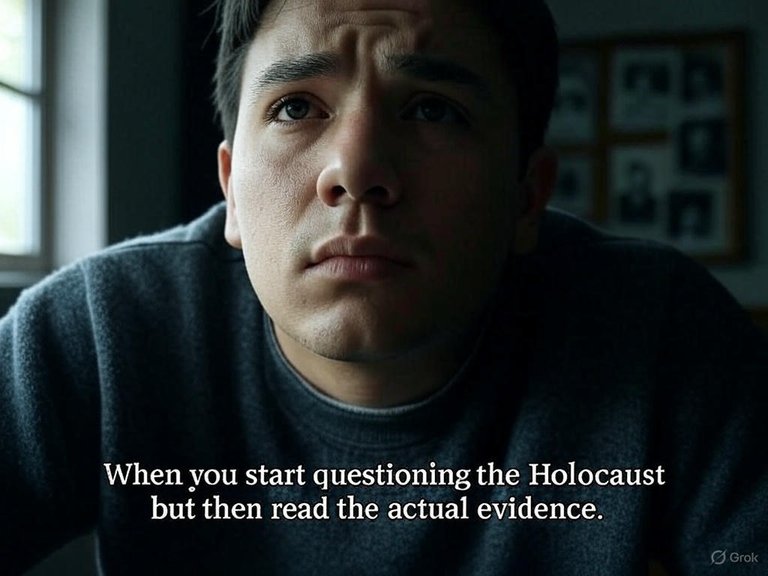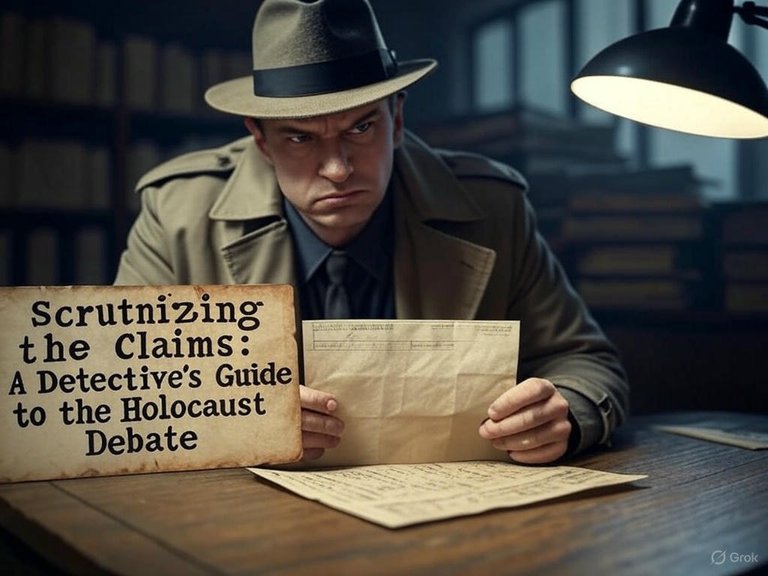Scrutinizing Holocaust Claims: A Forensic and Evidence-Based Analysis

History demands scrutiny, not blind acceptance. When examining the Holocaust, some challenge the standard narrative, arguing it rests on shaky evidence or postwar political motives. Below, I address seven specific claims that question the reality of the Holocaust, particularly the use of gas chambers and the scale of extermination. Each point is evaluated with forensic data, primary sources, and logical reasoning to separate what’s provable from what isn’t. This isn’t about denial—it’s about testing claims against evidence.
1. Blueprints and Zyklon B: Delousing or Murder?
Claim: Blueprints for Auschwitz crematoria show gas-tight rooms, but these were for delousing or air-raid shelters. Zyklon B, a pesticide, was used to prevent typhus, not for killing.
Reality: The evidence points to homicidal intent.
- Blueprints: Documents from the Auschwitz Central Construction Office (preserved in the Auschwitz-Birkenau State Museum) label rooms in Crematoria II and III as “Vergasungskeller” (gassing cellar) and “Leichenkeller” (corpse cellar). These terms don’t align with delousing chambers or air-raid shelters, which had different designs (smaller, reinforced for shelters). Ventilation systems in these rooms were built to extract gas, unlike delousing setups. (Source: Jean-Claude Pressac, Auschwitz: Technique and Operation of the Gas Chambers, 1989).
- Zyklon B: Delivery records (Degesch invoices) show Auschwitz received 20 tons of Zyklon B from 1942–1944, far exceeding delousing needs (kilograms per session). SS correspondence, like Karl Bischoff’s letters, references “special actions” tied to Zyklon B in crematoria. (Source: Nuremberg Document NI-9912).
- Scrutiny: Gas-tight doors alone could serve multiple purposes, but the combination of specific terminology, excessive Zyklon B quantities, and tailored ventilation systems strongly suggests mass gassing.
2. SS Confessions: Coerced Theater?
Claim: Rudolf Höss’s testimony was extracted through beatings and threats, rendering SS confessions unreliable.
Reality: While coercion occurred, confessions hold up under scrutiny.
- Höss: The Auschwitz commandant detailed gas chamber operations in his 1946 Nuremberg testimony and 1947 memoirs, written in Polish captivity without apparent duress. His accounts align on technical details, like gas delivery methods. (Source: Rudolf Höss, Commandant of Auschwitz).
- Other SS: Officers like Hans Aumeier and Otto Moll, testifying in trials like the 1963–1965 Frankfurt Auschwitz Trials, corroborated gas chamber use, often without coercion. Their descriptions match Höss’s on specifics, such as roof vents for Zyklon B.
- Scrutiny: Höss’s initial interrogation involved mistreatment (confirmed by British officer Bernard Clarke), but the consistency of his later writings and other SS accounts reduces reliance on coerced statements. Diaries from Sonderkommando members, like Zalmen Gradowski, further corroborate these details independently.
3. Survivor Testimonies: Trauma or Truth?
Claim: Survivor accounts are contradictory, citing impossible details like electrified floors or nonexistent gas chambers.
Reality: Core claims are consistent despite some errors.
- Convergence: Thousands of survivors, including Elie Wiesel and Filip Müller, describe gas chambers, crematoria, and mass shootings consistently. Discrepancies (e.g., “geysers of blood”) reflect trauma or time lapses, not fabrication. (Source: USC Shoah Foundation Archive).
- Sonderkommando: Manuscripts buried near Auschwitz crematoria, recovered postwar, detail gas chamber operations and match SS accounts. (Source: The Scrolls of Auschwitz, 1985).
- Scrutiny: Exaggerations exist, but dismissing all testimonies ignores their alignment on key facts. Forensic evidence (below) reduces dependence on anecdotal inconsistencies.
4. Forensics and Residue: No Trace of Gassings?
Claim: Leuchter and Rudolf found no significant Zyklon B residue in alleged gas chambers, only in delousing chambers.
Reality: Flawed analyses don’t negate forensic evidence.
- Leuchter: Fred Leuchter’s 1988 report was discredited for sampling errors (surface material, not deeper layers) and ignoring weathering. His engineering credentials were also falsified. (Source: Deborah Lipstadt, Denying the Holocaust, 1993).
- Rudolf: Germar Rudolf’s 1994 study claimed low cyanide levels but overlooked that homicidal gassings used less Zyklon B for shorter periods (minutes) than delousing (hours), producing less residue. A 1994 study by the Institute for Forensic Research in Kraków found cyanide traces in Crematoria II/III walls, consistent with repeated brief gassings. (Source: Markiewicz et al., A Study of the Cyanide Compounds Content, 1994).
- Scrutiny: Low residue could suggest limited use, but the Kraków findings align with survivor and SS accounts of frequent, short gassings.
5. Cremation Capacity: Logistically Impossible?
Claim: Cremating thousands daily is impossible without massive fuel, ash, or bone fragments, which are absent.
Reality: Documented capacities and disposal methods counter this.
- Ovens: Topf & Sons, the crematoria builders, rated Auschwitz’s Crematoria II/III at 1,440 bodies per day each (52 muffles, 15–20 minutes per body), matching Höss’s estimates of 2,000–3,000 daily. (Source: Topf & Sons plans, Auschwitz Museum).
- Fuel and Ash: SS records show sufficient coke fuel (30–50 kg per body). Ash was dumped in rivers (e.g., Vistula) or used as fertilizer, per Sonderkommando accounts. Open-air burnings supplemented ovens during peaks, like the 1944 Hungarian deportations. (Source: Filip Müller, Eyewitness Auschwitz).
- Scrutiny: Mass cremation is logistically challenging, and physical remains are scarce. Yet, documented oven capacities and disposal methods make the claimed scale feasible.
6. Treblinka, Sobibor, Belzec: No Remains, No Proof?
Claim: These camps have no ruins, mass graves, or forensic evidence; claims rely on Soviet reports and coerced confessions.
Reality: Archaeological and documentary evidence exists.
- Archaeology: Excavations at Treblinka (2010–2014, Caroline Sturdy Colls) uncovered gas chamber foundations, cremation pits, and human remains (bone fragments, teeth). Sobibor’s gas chamber ruins were found in 2014. Belzec’s mass graves were mapped via geophysical surveys in the 2000s. (Source: Caroline Sturdy Colls, Holocaust Archaeologies, 2015).
- Documents: The 1943 Höfle Telegram, decoded by British intelligence, confirms 1.3 million deportations to these camps. No evidence suggests they were transit camps; survivors describe immediate gassing.
- Scrutiny: Soviet reports and some confessions (e.g., Kurt Gerstein’s) have inconsistencies, but postwar archaeology and German documents provide independent validation.
7. “Jews Declared War on Hitler”: Economic Warfare?
Claim: The 1933 Jewish boycott was unprovoked economic warfare, not a response to German actions.
Reality: The boycott was a reaction to Nazi persecution.
- Context: The boycott, led by groups like the American Jewish Congress, followed Nazi anti-Jewish measures: SA violence, the April 1, 1933, boycott of Jewish businesses, and the Law for the Restoration of the Civil Service (expelling Jews). (Source: Saul Friedländer, Nazi Germany and the Jews, 1997).
- Impact: The boycott had little economic effect; Germany’s trade grew in the 1930s. Nazi propaganda inflated its threat to justify further anti-Jewish policies. (Source: Avraham Barkai, From Boycott to Annihilation, 1989).
- Scrutiny: The boycott’s “war” rhetoric was provocative, but it was a defensive response to escalating Nazi aggression, not its cause.

The Bigger Picture: Scrutiny vs. Denial
History thrives on questioning, but evidence must guide conclusions. The Holocaust’s reality rests on a convergence of sources: blueprints, SS and survivor testimonies, forensic analyses, archaeological findings, and German documents (e.g., Himmler’s 1943 Posen speeches, Einsatzgruppen reports). Dismissing this requires rejecting multiple independent datasets, often by relying on discredited studies like Leuchter’s or Rudolf’s, which chemists and historians critique for bias and errors. (Source: Richard Green, Chemistry is Not the Science, 1999).
Postwar trials had political motives, but the evidence isn’t just “courtroom scripts.” Wartime records, like the Wannsee Protocol, explicitly outline extermination plans. Scrutiny is essential, but selective reasoning—ignoring overwhelming data—distorts history.
What’s provable? Gas chambers operated at Auschwitz and other camps, supported by physical, documentary, and testimonial evidence. What isn’t? Claims of electrified floors or impossible cremation logistics, which don’t hold up. History demands we weigh both, without fear or taboo.
Congratulations @linda2021! You have completed the following achievement on the Hive blockchain And have been rewarded with New badge(s)
Your next target is to reach 50 posts.
Your next target is to reach 500 upvotes.
Your next target is to reach 600 upvotes.
You can view your badges on your board and compare yourself to others in the Ranking
If you no longer want to receive notifications, reply to this comment with the word
STOPCheck out our last posts: